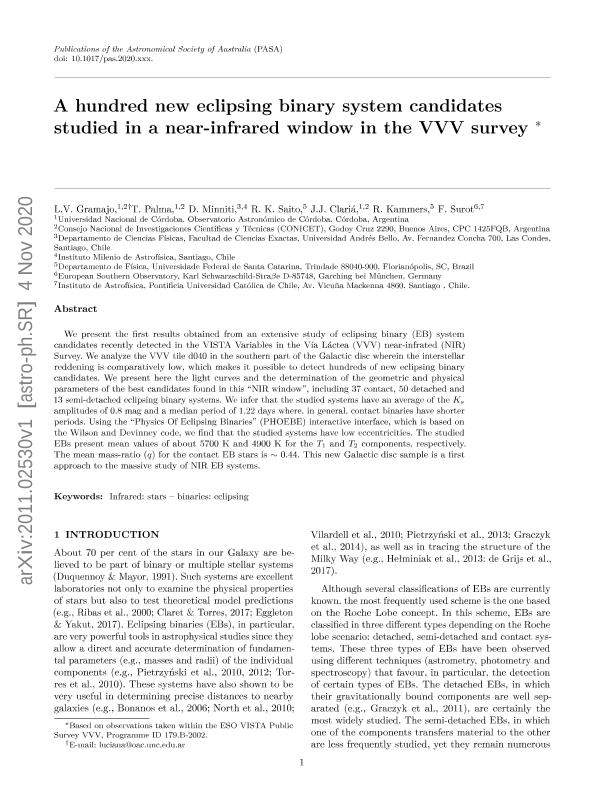Artículo
A hundred new eclipsing binary system candidates studied in a near-infrared window in the VVV survey
Gramajo, Luciana Veronica ; Palma, Tali
; Palma, Tali ; Minniti, D.; Saito, R. K.; Clariá, Juan José
; Minniti, D.; Saito, R. K.; Clariá, Juan José ; Kammers, R.; Surot, F.
; Kammers, R.; Surot, F.
 ; Palma, Tali
; Palma, Tali ; Minniti, D.; Saito, R. K.; Clariá, Juan José
; Minniti, D.; Saito, R. K.; Clariá, Juan José ; Kammers, R.; Surot, F.
; Kammers, R.; Surot, F.
Fecha de publicación:
10/12/2020
Editorial:
Csiro Publishing
Revista:
Publications Of The Astronomical Society Of Australia
ISSN:
1323-3580
e-ISSN:
1448-6083
Idioma:
Inglés
Tipo de recurso:
Artículo publicado
Clasificación temática:
Resumen
We present the first results obtained from an extensive study of eclipsing binary (EB) system candidates recently detected in the VISTA Variables in the Vía Láctea (VVV) near-infrared (NIR) Survey. We analyse the VVV tile d040 in the southern part of the Galactic disc wherein the interstellar reddening is comparatively low, which makes it possible to detect hundreds of new EB candidates. We present here the light curves and the determination of the geometric and physical parameters of the best candidates found in this ‘NIR window’, including 37 contact, 50 detached, and 13 semi-detached EB systems. We infer that the studied systems have an average of the Ks amplitudes of 0.8 mag and a median period of 1.22 days where, in general, contact binaries have shorter periods. Using the ‘Physics Of Eclipsing Binaries’ (PHOEBE) interactive interface, which is based on the Wilson and Devinney code, we find that the studied systems have low eccentricities. The studied EBs present mean values of about 5 700 and 4 900 K for the T1 and T2 components, respectively. The mean mass ratio (q) for the contact EB stars is ∼0.44. This new galactic disk sample is a first look at the massive study of NIR EB systems.
Palabras clave:
Infrared: stars
,
Binaries: eclipsing
Archivos asociados
Licencia
Identificadores
Colecciones
Articulos(CCT - CORDOBA)
Articulos de CTRO.CIENTIFICO TECNOL.CONICET - CORDOBA
Articulos de CTRO.CIENTIFICO TECNOL.CONICET - CORDOBA
Citación
Gramajo, Luciana Veronica; Palma, Tali; Minniti, D.; Saito, R. K.; Clariá, Juan José; et al.; A hundred new eclipsing binary system candidates studied in a near-infrared window in the VVV survey; Csiro Publishing; Publications Of The Astronomical Society Of Australia; 37; 10-12-2020; 54-64
Compartir
Altmétricas



